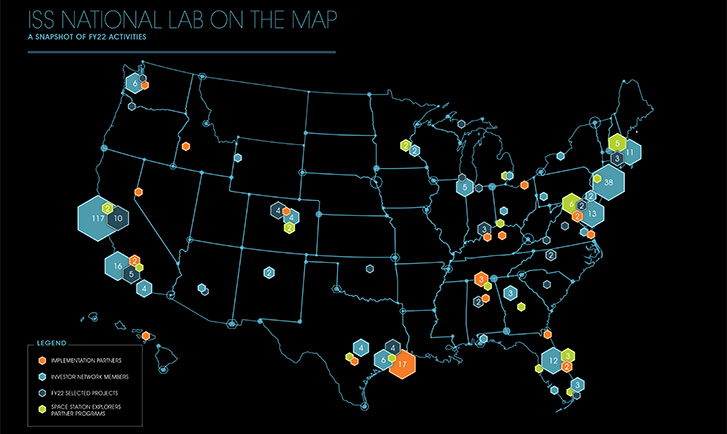This was a record-setting year for results and subsequent successes stemming from ISS National Lab-sponsored R&D. Nearly 50 peer-reviewed publications related to ISS National Lab-sponsored research were published in FY22 (citations for which are in Appendix C)—the most ever identified in a single fiscal year. This brings the total number of peer-reviewed publications related to R&D sponsored by the ISS National Lab to more than 200. These publications disseminate valuable findings from ISS-based research that form the knowledge base for future applied research to build on.
“Since 2016, the National Science Foundation has worked with the ISS National Lab to enable fundamental science in low Earth orbit. Insights gained from research conducted through this partnership will impact future energy sources, microelectronics, health, and other technologies that benefit life on Earth. Through collaborations such as these, we are expanding opportunities for researchers across the U.S.”
– Susan Margulies, NSF Assistant Director for Engineering
This year, 32 publications are related to research from NSF/CASIS joint solicitations (15 on tissue engineering and mechanobiology, and 17 on transport phenomena, combustion, and fluid dynamics). For example:
- Researchers at the Palo Alto Veterans Research Institute published three peer-reviewed articles about developing a model of sarcopenia (muscle loss due to aging) using engineered skeletal muscle to study muscle deterioration and test potential treatments for muscle wasting.
- A research team from the University of Maryland observed gaseous spherical cool diffusion flames on the ISS, representing the first time such flames have been observed in space or on the ground. A better understanding of cool flames could help improve engine efficiency and lead to cleaner emissions.
- Case Western Reserve University researchers showed how flame spread could be accelerated or suppressed during combustion in structures with confined geometries. Findings can be used to assess potential fire hazards in confined spaces (e.g., vehicles, tunnels, buildings, and spacecraft) and inform future fire codes.
Other examples of publications from FY22 include the following:
- Researchers from Emory University found that microgravity increases the proliferation of heart muscle cells derived from induced pluripotent stem cells—findings with important applications in regenerative medicine, disease modeling, and drug discovery. This investigation built upon the research team’s preliminary ground validation study.
- With microgravity-grown protein crystals, University of Toledo researchers were able to use neutron diffraction to determine the structure of an enzyme involved in the ability of salmonella and other bacteria to cause infection—something that had never been achieved on Earth. Results led to more accurate structural models of the enzyme, which could help develop improved antibiotics.
- University of Alabama Birmingham researchers published results that shed light on why space-grown protein crystals often have higher quality than Earth-grown ones. Findings could help predict which proteins may benefit most from crystallization in microgravity.
- A publication discussed the detection of cosmic rays over an eight-year period on the ISS from the Alpha Magnetic Spectrometer-02, a particle physics detector seeking to advance knowledge of the universe and its origin.
- Two publications detail results from Genes in Space student-led investigations: one developed a technique to monitor the immune system of astronauts in space, and another proposed a way to monitor DNA changes in astronauts as they are happening.
“As the ISS National Lab progresses from a science test bed to a user facility for applied science and commercial development, we are seeing impactful results from the past decade of ISS National Lab-sponsored R&D. These results demonstrate the value the ISS National Lab will continue to provide as the nation drives toward the LEO economy of the future.”
– Elizabeth Cantwell, CASIS Board of Directors Chair
Additionally, a perspective paper was published in Stem Cell Reports discussing the outcomes of a Biomanufacturing in Space Symposium that the ISS National Lab co-hosted. The symposium was the first step in developing a roadmap to establish a sustainable biomanufacturing market in LEO. ISS National Lab staff also authored a conference proceedings paper on in-space production applications published in TechConnect Briefs.
In FY22, two patents related to ISS National Lab-sponsored research were granted: one to Hewlett Packard Enterprise for a novel electronic cooling system related to the Spaceborne Computer and one to Made In Space (acquired by Redwire Space) for a sensor system for optical fiber manufacturing. A third patent was filed by the University of Alaska Anchorage related to biofuel production.
ISS National Lab-sponsored research also led to four products this fiscal year:
- The latest formulation of Procter and Gamble’s (P&G) Febreze Unstopables® Touch Fabric Spray is the first P&G product to incorporate materials based on the company’s ISS National Lab-sponsored research.
- More than 200 hours of footage captured through an ISS National Lab-sponsored project was used to create the Emmy-winning virtual reality series “Space Explorers: The ISS Experience” produced by Felix & Paul Studios in association with TIME. The fourth and final episode of the series, featuring the first spacewalk ever filmed in cinematic virtual reality, was released in FY22.
- Felix & Paul Studios also used the footage to produce “Space Explorers: The Infinite,” a traveling interactive exhibit in which viewers put on virtual reality headsets to experience what it is like to be an astronaut on the space station.
- Redwire Space achieved a significant milestone for LEO commercialization with the first sale of an optical crystal produced in its Industrial Crystallization Facility onboard the ISS—one of the first times a space-produced materials product has been sold on Earth.




